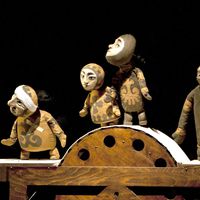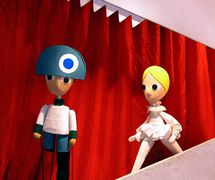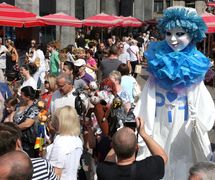The Republic of Croatia (Croatian: Republika Hrvatska), with its capital in Zagreb, is at the crossroads of Central Europe, South East Europe, and the Mediterranean. There are over a thousand islands along the Croatian coast of the Adriatic Sea; some of the larger ones are inhabited. Croatia declared its independence from Yugoslavia in 1991.
The first public puppetry performances in Zagreb in the Croatian language were held from 1916 onwards. The Teatar marioneta (Marionette Theatre) was founded in 1920 by the writer Velimir Deželić, the composer Božidar Širola, the painter and scenographer Ljubo Babić, and the poet Dragutin Domjanić, with the performance of the first Croatian puppet play, Petrica Kerempuh i spametni osel (Petrica Kerempuh and the Clever Donkey).
Between the two world wars, puppetry appeared as one of the more important preoccupations within the Sokol (Falcon) Movement that had originated in Bohemia, whence came the stimulus for its practice. There were some fifteen Sokol theatres in Croatia at that time and all of them used the marionette (string puppet) exclusively. That was also the case in Split – the Sokolsko kazalište lutaka (Sokol Puppet Theatre), founded in 1933, applied the marionette technique exclusively – and in Osijek, where along with the Sokolsko lutkarsko kazalište (Sokol Puppet Theatre), significant traces were left by the ethnic Czech Kazalište lutaka (Puppet Theatre).
A network of professional puppet theatres was set up after World War II. The first puppet theatre was founded in Split in 1945. In Zagreb, Vlado Habunek, the theatre director, and Radovan Ivšić, the poet, who had first introduced the glove puppet technique in the company Družina mladih (Youth Company, 1939-1945), founded Kazalište lutaka (Puppet Theatre) in 1947, with the participation of the well-known German actress, Tilla Durieux. The theatre was re-named Zagrebačko kazalište lutaka (Zagreb Puppet Theatre) in 1948. A puppet theatre was founded in Zadar in 1952, as well as another, the Dječje kazalište (Children’s Theatre) in Osijek, while Gradsko kazalište lutaka (City Puppet Theatre) in Rijeka was set up in 1960. Initially, the puppetry techniques applied were fairly restrictive and traditional. At that time, the marionette was the synonym for the puppet, but glove puppets and rod puppets were also used. The Rijeka puppeteers were the first to adopt the illuminative technique (black light theatre).
In its co-operation with Czech and Slovakian puppeteers, Dječje kazalište u Osijeku (Children’s Theatre in Osijek) opened up to interaction between the live actor and the puppet. However, the authentic values of Croatian puppetry were distinctive auteur styles and technological forms. From the 1960s, the painter and scenographer, Berislav Deželić, created a singular style in his work at Zagrebačko kazalište lutaka (Zagreb Puppet Theatre), reducing the puppet to a symbol, ridding it almost completely of any anthropomorphic quality.
A much more radical and revolutionary turnabout occurred during the 1970s in the theatre company, Kazalište lutaka Zadar (Zadar Puppet Theatre). Starting out from the assumption that the puppet was in the function of the scenography, and the scenography in the function of the puppet, puppet designer and scenographer Branko Stojaković and director Luko Paljetak created wondrous effects through dynamic transformations and framing. For them, puppetry is primarily visual poetry and music, and only then text, which they showed programmatically in the visualization of the production Postojani kositreni vojnik (The Steadfast Tin Soldier, 1978). During the 1980s, Zlatko Bourek found specific technological alternatives for his grotesque puppets.
At the end of 1980s, there was an increased tendency towards large ensemble productions, from Zagreb’s Osman and Zadar’s Judita to Djevojčica sa žigicama (The Little Match Girl) in Osijek. Rene Medvešek’s work has attracted attention since the 1990s. His productions of Mrvek i Crvek (Mrvek and Crvek) and Nadpodstolar Martin (The Shoe of All Shoes) brought together live acting, mime and animation.
Since the very beginning, puppeteers have devoted special attention to staging Croatian literature, particularly works by the “Croatian Andersen”, Ivana Brlić-Mažuranić. National puppetry drama is based on plays by Vladimir Nazor, Radovan Ivšić, Vojmil Rabadan, Milan Čečuk, Borislav Mrkšić, Luko Paljetak, Ivan Bakmaz, Zlatko Krilić, and the like, and is mainly imbued with the spirit and idiom of folk tales. The Petrica Kerempuh character appears in many plays. He derives from oral legend and is the embodiment of a wag but also of a rebel and mouthpiece for small ordinary folk. His ironical comments spare no one. As a puppet personage, he belongs to the Hanswurst, Punch and Judy, Karagöz, and Kasperle family. An important contribution was made to Croatian puppetry by the alternative and amateur theatre Kazališna družina “Coccolemocco” (Coccolemocco Company) with its production of Jedan dan u životu Ignaca Goloba (One Day in the Life of Ignac Golob), and by the movement that was born under the influence of the pedagogue, Vlasta Pokrivka, in her characteristic creation of puppets made from natural materials, pumpkins and un-worked wood.
Puppet Festivals
The oldest and largest puppetry festival in Croatia – for many years the only international one – is the PIF (the International Festival of Puppetry Theatres, Pupteatra Internacia Festivalo in Esperanto). It was founded in Zagreb by Esperanto students and has been held regularly every year since 1968. The SLUK is a get-together of Croatian puppeteers and puppetry theatres which, since its inception in Opatija in 1969, has been held every two years, in Osijek as a rule. Puppetry productions are an important segment of the programme at the Međunarodni dječji festival (International Children’s Festival), founded in Šibenik in 1958. Revija lutkarskih kazališta (Review of Puppetry Theatres) has been held in Rijeka since 1996, while Vukovarsko lutkarsko proljeće (Vukovar Puppetry Spring) takes place in the Vukovar-Srijem County.
Teaching and Training
There has been a Department of Theatre Arts at Umjetnička akademija u Osijeku (Osijek Academy of Arts) since 2004. The Academy is part of Sveučilište Josipa Jurja Strossmayera u Osijeku (Osijek’s Josip Juraj Strossmayer University). The Department of Theatre Arts offers courses in Acting and Puppetry. The Academy is the first institution of higher learning in Croatia at which the puppetry art can be studied. Lectures in Puppetry have been and are being given by numerous renowned teachers from Croatia and abroad, among them Edi Majaron from Slovenia.
Since 1968, various courses that include Puppetry are available for all students at the Učiteljski fakultet (Faculty of Teacher Education) in Zagreb. Depending on the type of course, they include History and Theory of the Puppet Theatre, Dramaturgy, Making and Animation of Puppets, and the like. There are also other teacher education faculties in Croatia (as, for example, in Split, Osijek, and Rijeka) which offer various courses that include Puppetry.
A centre, Međunarodni centar za usluge u kulturi (International Cultural Centre) was founded in Zagreb in 1972 by a group that had already gained experience in organizing the PIF International Festival of Puppetry Theatres. The Centre has an extensive collection of videotapes, photographs, texts, books and puppets. It organizes puppetry seminars, lectures and round-tables on puppetry. Under the name Lutkanija, it publishes books on the history and theory of the puppet theatre, as well as scripts for puppet performances (originals and translations). In addition, Lutkarska družina “Lutkobus” (Lutkobus Puppetry Company) is also attached to the Centre. The first seat of the Croatian Centre of UNIMA was also initially attached to the Centre.
The institute Zavod za povijest hrvatske književnosti, kazališta i glazbe (Institute for the History of Croatian Literature, Theatre and Music), founded in 1965 as part of Hrvatska akademija znanosti i umjetnosti (HAZU, Croatian Academy of Sciences and Arts), is the nucleus of theatre archives in Croatia. Archival and historical data on professional theatres and puppetry companies (drama texts, sketches of costumes and scenography, photographs, press clippings) are systematically collected and stored at the Department of Theatre History.
The LuKa Review has been published by Zagrebačko kazalište lutaka (Zagreb Puppet Theatre) since 1995.
Bibliography
- Hrvatsko lutkarstvo/Croatian Puppetry. Ed. Livija Kroflin. Zagreb: Croatian Centre of UNIMA & International Cultural Centre, 1997. (In Croatian and English)
- Hrvatsko lutkarstvo/Croatian Puppetry. Second edition, revised and expanded. Zagreb: UNIMA-Croatia, 2000. (In Croatian and English)
- Kroflin, Livija. Estetika PIF-a [The Aesthetics of the PIF]. Zagreb: Međunarodni centar za usluge u kulturi, 2012.
- Kroflin, Livija. Zagrebačka zemlja Lutkanija [Zagreb Country Lutkanija]. Zagreb: Međunarodni centar za usluge u kulturi, 1992.















